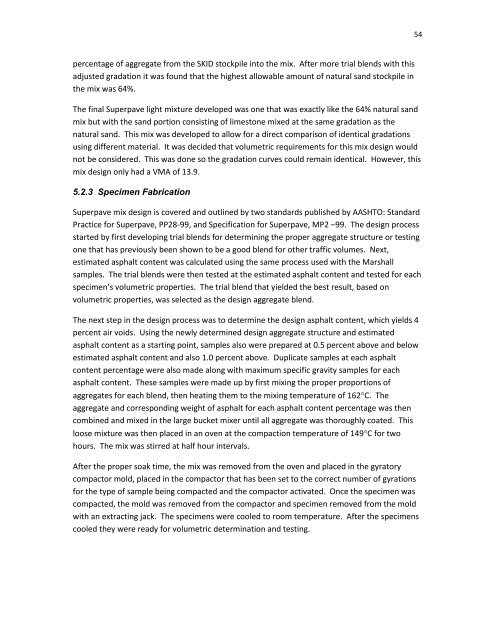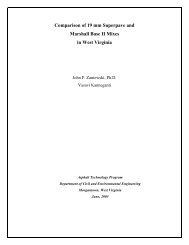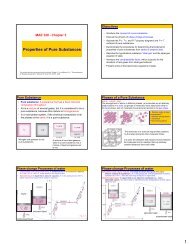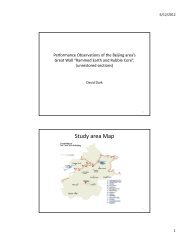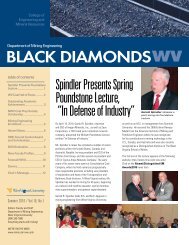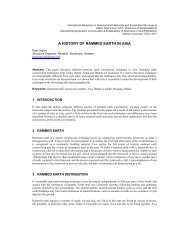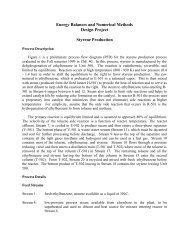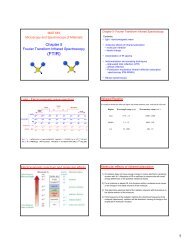Comparison of 9.5 mm SuperPave and Marshall Wearing I Mixes in ...
Comparison of 9.5 mm SuperPave and Marshall Wearing I Mixes in ...
Comparison of 9.5 mm SuperPave and Marshall Wearing I Mixes in ...
Create successful ePaper yourself
Turn your PDF publications into a flip-book with our unique Google optimized e-Paper software.
54percentage <strong>of</strong> aggregate from the SKID stockpile <strong>in</strong>to the mix. After more trial blends with thisadjusted gradation it was found that the highest allowable amount <strong>of</strong> natural s<strong>and</strong> stockpile <strong>in</strong>the mix was 64%.The f<strong>in</strong>al Superpave light mixture developed was one that was exactly like the 64% natural s<strong>and</strong>mix but with the s<strong>and</strong> portion consist<strong>in</strong>g <strong>of</strong> limestone mixed at the same gradation as thenatural s<strong>and</strong>. This mix was developed to allow for a direct comparison <strong>of</strong> identical gradationsus<strong>in</strong>g different material. It was decided that volumetric requirements for this mix design wouldnot be considered. This was done so the gradation curves could rema<strong>in</strong> identical. However, thismix design only had a VMA <strong>of</strong> 13.<strong>9.5</strong>.2.3 Specimen FabricationSuperpave mix design is covered <strong>and</strong> outl<strong>in</strong>ed by two st<strong>and</strong>ards published by AASHTO: St<strong>and</strong>ardPractice for Superpave, PP28-99, <strong>and</strong> Specification for Superpave, MP2 –99. The design processstarted by first develop<strong>in</strong>g trial blends for determ<strong>in</strong><strong>in</strong>g the proper aggregate structure or test<strong>in</strong>gone that has previously been shown to be a good blend for other traffic volumes. Next,estimated asphalt content was calculated us<strong>in</strong>g the same process used with the <strong>Marshall</strong>samples. The trial blends were then tested at the estimated asphalt content <strong>and</strong> tested for eachspecimen’s volumetric properties. The trial blend that yielded the best result, based onvolumetric properties, was selected as the design aggregate blend.The next step <strong>in</strong> the design process was to determ<strong>in</strong>e the design asphalt content, which yields 4percent air voids. Us<strong>in</strong>g the newly determ<strong>in</strong>ed design aggregate structure <strong>and</strong> estimatedasphalt content as a start<strong>in</strong>g po<strong>in</strong>t, samples also were prepared at 0.5 percent above <strong>and</strong> belowestimated asphalt content <strong>and</strong> also 1.0 percent above. Duplicate samples at each asphaltcontent percentage were also made along with maximum specific gravity samples for eachasphalt content. These samples were made up by first mix<strong>in</strong>g the proper proportions <strong>of</strong>aggregates for each blend, then heat<strong>in</strong>g them to the mix<strong>in</strong>g temperature <strong>of</strong> 162 C. Theaggregate <strong>and</strong> correspond<strong>in</strong>g weight <strong>of</strong> asphalt for each asphalt content percentage was thencomb<strong>in</strong>ed <strong>and</strong> mixed <strong>in</strong> the large bucket mixer until all aggregate was thoroughly coated. Thisloose mixture was then placed <strong>in</strong> an oven at the compaction temperature <strong>of</strong> 149 C for twohours. The mix was stirred at half hour <strong>in</strong>tervals.After the proper soak time, the mix was removed from the oven <strong>and</strong> placed <strong>in</strong> the gyratorycompactor mold, placed <strong>in</strong> the compactor that has been set to the correct number <strong>of</strong> gyrationsfor the type <strong>of</strong> sample be<strong>in</strong>g compacted <strong>and</strong> the compactor activated. Once the specimen wascompacted, the mold was removed from the compactor <strong>and</strong> specimen removed from the moldwith an extract<strong>in</strong>g jack. The specimens were cooled to room temperature. After the specimenscooled they were ready for volumetric determ<strong>in</strong>ation <strong>and</strong> test<strong>in</strong>g.


